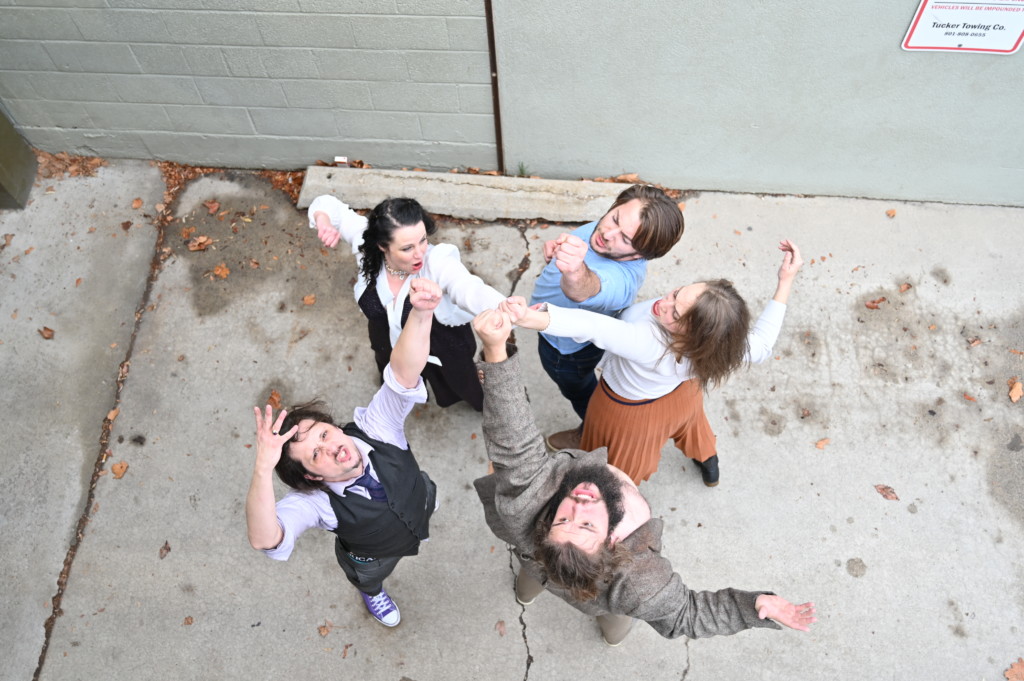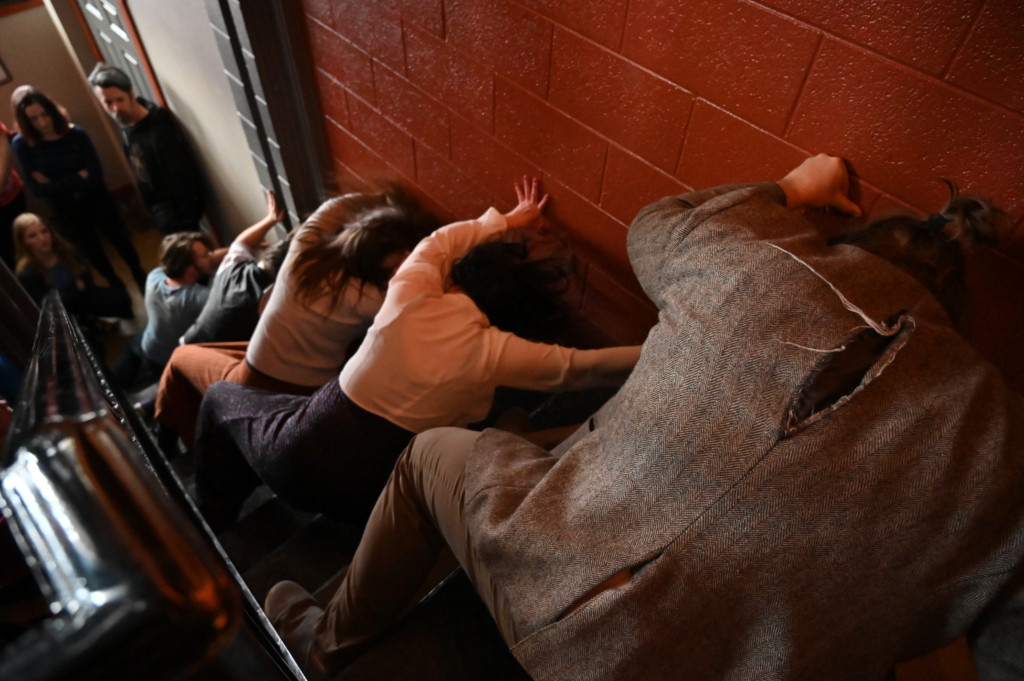Earlier this winter, one of the most unconventional yet captivating productions to arrive on the Salt Lake City performing arts scene was Thank You, Theobromine, by SONDERimmersive. Set in The Chocolate Conspiracy shop, near the corner of 800 South and 300 West, the show immersed its audience members, kept always on the move, in dramatic scenes incorporating dance, theater, music and samples of chocolate.
After an eight-week hiatus, the show has returned in a retooled, sharpened version with a new title – The Chocolatier. And, it retains all of its original fascinating, enigmatic appeal while opening the door wider for audience members (and chocolate consumers) to appreciate a craft where merely explaining or observing the technique and science hardly does justice to the magnificent, passionate, hard-won stories behind its creations.

The immersive experience intensifies the chocolatier’s range of complex problem solving, temperamentally sensitive ingredients, personal disappointments, sacrifices, frustrations with those who might see the final creation as just another ordinary chocolate bar or confection and then rare moments of pure triumph and ecstasy. With a cast of seven actors, The Chocolatier amplifies dramatically the eco-conscious, methodical, even soft-spoken actualities of the shop’s founder, A. J. Wentworth. Based on the response to the show’s earlier version, Wentworth obviously reinforced his initial confidence and generous willingness to allow his concise two-story shop to be restaged for the show.
The show’s broadest format remains the same: strictly limited to 30 members maximum per performance, who gather under a tent just outside the shop. Audience members sign up for their experience, as based on the characters of the five groups – The Hero, The Rejector, The Altruist, The Libra and The Divine. In the restaged production, there are new elements that tee up the forthcoming experience for the audience in waiting. Secrets are whispered into the ear and passed from one person to another. A brief passage or story is read from a handwritten journal. Samples of the shop’s hot chocolate along with raw cacao bits are offered. The prologue vibe is like a cocktail party where there is just enough uneasiness for people to stay either to themselves or within their cliques or their guests or mingle and introduce themselves to other audience members.

Once the audience enters the shop, various actors swarm upon individuals, whisking them away or directing them to a specified location. From that point, each member of the audience is destined for their unique experience. As in the previous version, no one ever experiences all of the possible scenes that encompass The Chocolatier in one performance or the full spectrum of each character.
In the original version of the show, this critic experienced it via The Hero group. This time, it was the Divine group, starting on a seductive note that truly brings home the potential meaning of decadence when mentioned in the same breath as chocolate. At first, there is the disarming sensation that this character is the quintessential avatar of the chocolatier pursuing ground-breaking methods for purity and authenticity. The Divine alone, however, cannot encompass the whole nature of chocolate genius. But, embracing The Divine’s alluring muse is worth the patience, especially if the reward is an exquisite truffle that is gobsmacking in its transcendent pleasure.

The creative team is virtually intact from the original version. Graham Brown and Rick Curtiss lead the creative team that includes playwright and Sackerson producer Morag Shepherd (along with Brown, Curtiss, Morag Shepherd, Michael Watkiss — who works at the shop with Wentworth as a chocolatier — and Molly Chrisman), scenography by Joe Wheeler (assisted by other production team members) and composer Nick Foster, who also is a member of the Salt Lake Electric Ensemble.
Enhancing the original version, the choreographed movement, including new phrases, is positioned close enough to engulf the spectators, especially on the staircase or in a second-story room or outdoor patio. There is a good deal of acrobatic flourish. Foster’s accomplished soundscape scoring accentuates a scene’s narrative tone with appropriate ambience. Dialogue is terser than in the original, with excellent effect. One scene highlights a familiar juxtaposition in time management. Time for serene meditation, complete with cushions and lit candles, is valued. But, how does one even begin to savor it amid a rapid onslaught of paperwork, deadlines and urgent requests? The Grandmother from the previous version is replaced by The Grandfather and The Kid becomes The Sport, both of whom augment the quintet’s appearances with clarifying connections in sensitive emotion.
The Rejector’s tempestuous outbursts along with his shamelessly obsessive disregard for nuances that should matter are back in fine form, maybe even more unhinged than in the original — with the old-school projector for transparencies once again used as a strangely humorous prop. The Libra helps sort out the mundane routines from chaotic, loud and exotic ruptures in life, which define any risk-taking entrepreneur’s existence. The Altruist leverages dance’s communicative capacities for expressing economically yet thoroughly a complex range of human emotions in some of the most impressive movement on display in the performance. And, of course, The Hero, who appears as an intriguing anchor for the whole experience: vulnerable, utmost in conscientious sincerity and convinced that the story behind each chocolate varietal is not just magic but a subtext for deep meaning and life purpose.
Three months ago, as mentioned in The Utah Review, “Thank You Theobromine is a meta experience. A question that runs throughout the immersive experience persistently asks what we are willing to risk for our passion. The creative team that transformed The Chocolate Conspiracy shop into Thank You Theobromine demonstrates why taking risks, when they are not predicated on fears, gives us the opportunity to live the best story we really want for ourselves.”

New performing arts experiences, particularly when they bust out of the traditional proscenium and four walls of the theater, should be replicated, not allowed to gather dust. The Chocolatier invites audience members to envision their own synthesis among the five archetypes presented here. The production team was determined and motivated to invest more creative risk in restaging the show and the results pay handsomely in that investment. Having seen the show from The Hero perspective in its first iteration and now from The Divine journey in its newer form is compelling enough to see what the experience would be like in groups representing the three other archetypes.
There are rotating casts of actors for the new version: The Hero, originated by Watkiss, performed by Watkiss and Barrett Ogden; The Rejector, originated by Curtiss, performed by Curtiss and Jacob Baird; The Altruist, originated by Lauren Payne. performed by Landon Craczek and Amber Golden; The Libra, originated by Rebecca Aneloski, performed by Catherine Mortimer and Emma Sargent; The Divine; originated by Elizabeth Golden, performed by Danell Hathaway and Nadia Sine; The Grandparent, originated by Sarah Shippobotham, performed by Joseph Wheeler, and Sport, originated by Bella Estrada-Brown, performed by Estrada-Brown, Oliver Estrada-Brown, Stormy Bradley, and Reya Handman.
Performances run the two weekends of March 13-15 and March 20-22, with performances on Fridays at 6 and 9 p.m., Saturdays at 8 p.m. and Sundays at 4 and 7 p.m.
For more information about tickets see The Chocolatier website. The show also is presented with the support of the Utah Arts Alliance.
